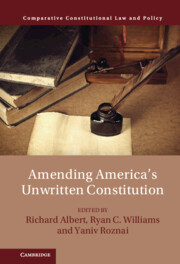Book contents
- Amending America’s Unwritten Constitution
- Comparative Constitutional Law and Policy
- Amending America’s Unwritten Constitution
- Copyright page
- Contents
- Contributors
- Acknowledgments
- Introduction A Return to Constitutional Basics: Amendment, Constitution, and Writtenness
- 1 The Unwritten Constitutions of the United States
- 2 Enumerating Amendments
- 3 Change Is the Only Constant: Unwritten Amendments and the Courts
- 4 The Role of the People in Unwritten Amendments
- 5 Unwritten State Constitutions? In Search of Constitutional Communities
- 6 State Constitutions and the Interaction between Formal Amendment and Unwritten Commitments
- 7 The Drive for a National Popular Vote for the Presidency: A Case Study in Amending the Unwritten Constitution
- 8 The Trump Presidency, the Racial Realignment, and the Future of Constitutional Norms
- 9 Amending an Unwritten Constitution: Comparative Perspectives
- 10 The Unwritten Foundations of (All) Written Constitutions
- Index
9 - Amending an Unwritten Constitution: Comparative Perspectives
Published online by Cambridge University Press: 13 October 2022
- Amending America’s Unwritten Constitution
- Comparative Constitutional Law and Policy
- Amending America’s Unwritten Constitution
- Copyright page
- Contents
- Contributors
- Acknowledgments
- Introduction A Return to Constitutional Basics: Amendment, Constitution, and Writtenness
- 1 The Unwritten Constitutions of the United States
- 2 Enumerating Amendments
- 3 Change Is the Only Constant: Unwritten Amendments and the Courts
- 4 The Role of the People in Unwritten Amendments
- 5 Unwritten State Constitutions? In Search of Constitutional Communities
- 6 State Constitutions and the Interaction between Formal Amendment and Unwritten Commitments
- 7 The Drive for a National Popular Vote for the Presidency: A Case Study in Amending the Unwritten Constitution
- 8 The Trump Presidency, the Racial Realignment, and the Future of Constitutional Norms
- 9 Amending an Unwritten Constitution: Comparative Perspectives
- 10 The Unwritten Foundations of (All) Written Constitutions
- Index
Summary
In this chapter, the author offers a comparative outlook on whether and how we might understand the act of “amending” America’s unwritten Constitution. Drawing upon examples from the United States and the United Kingdom, the author argues that the unwritten rule for amending an unwritten constitution is “Just Do It.” Unwritten constitutions are amended when relevant political actors simply ignore existing conventions or taken-for-granted propositions about the constitutional order. But, for such an action to lead to an “amendment,” the change must “stick” – subsequent actors must either treat the prior convention as now merely optional or, more strongly, treat the new practice as a new convention. One condition for “sticking,” he explains, is that those who breach the prior convention offer an explanation for the breach that (a) seems reasonable at the moment of breach and that (b) identifies a large enough class of similar occasions for breach in which departing from the convention would also seem reasonable. Such explanations provide the basis for the sense of obligation (or, sometimes, the sense of “optionality”) that characterizes elements of unwritten constitutions.
Keywords
- Type
- Chapter
- Information
- Amending America's Unwritten Constitution , pp. 203 - 216Publisher: Cambridge University PressPrint publication year: 2022



